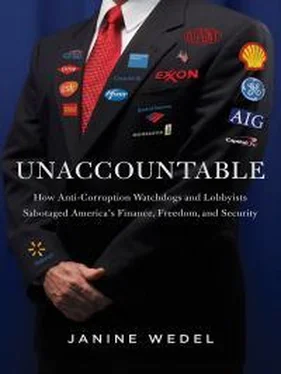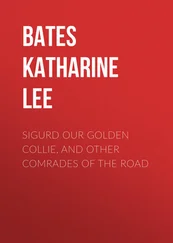In 2011, Standard & Poor’s downgraded the U.S. debt rating.
10. Louise Story, Landon Thomas, Jr., and Nelson D. Schwartz, “Wall St. Helped to Mask Debt Fueling Europe’s Crisis.” New York Times, February 13, 2010, p. A1 (http://www.nytimes.com/2010/02/14/business/global/14debt.html?pagewanted=1).
11. Susan Beck, “The SEC’s Internal Battles over Goldman Sachs Probe.” The Am Law Daily, April 7, 2014 (http://www.americanlawyer.com/home/id=1202650075059/The+SECs+Internal+Battles+over+Goldman+Sachs+Probe%3Fmcode=1382379838036&curindex=2).
12. Robert Schmidt, “SEC Goldman Lawyer Says Agency Too Timid on Wall Street Misdeeds.” Bloomberg, April 8, 2014 (http://www.bloomberg.com/news/2014-04-08/sec-goldman-lawyer-says-agency-too-timid-on-wall-street-misdeeds.html).
13. Greg Smith, “Why I Am Leaving Goldman Sachs.” New York Times, March 14, 2012, p. A27 (http://www.nytimes.com/2012/03/14/opinion/why-i-am-leaving-goldman-sachs.html?pagewanted=all&_r=0p).
14. Robert Mendick, “Blair Inc: How Tony Blair Makes His Fortune.” The Telegraph, January 7, 2012 (http://www.telegraph.co.uk/news/politics/tony-blair/8999847/Blair-Inc-How-Tony-Blair-makes-his-fortune.html).
15. On advising Gaddafi: Robert Mendick, “Tony Blair’s Six Secret Visits to Col. Gaddafi.” The Telegraph, September 24, 2011 (http://www.telegraph.co.uk/news/politics/tony-blair/8787074/Tony-Blairs-six-secret-visits-to-Col-Gaddafi.html); Peter Oborne, “On the Desert Trail of Tony Blair’s Millions.” The Telegraph, September 23, 2011 (http://www.telegraph.co.uk/news/politics/tony-blair/8784596/On-the-desert-trail-of-Tony-Blairs-millions.html).
On serving as Middle East peace envoy: BBC, “Blair Appointed Middle East Envoy,” BBC News, June 27, 2007 (http://news.bbc.co.uk/2/hi/6244358.stm).
16. James Fallows, “An Unfortunate Decision by Peter Orszag.” The Atlantic, December 10, 2010 (http://www.theatlantic.com/politics/archive/2010/12/an-unfortunate-decision-by-peter-orszag/67822/).
17. Monika Bauhr and Naghmeh Nasiritousi, “Why Pay Bribes? Collective Action and Anticorruption Efforts.” Working Paper Series 2011:18, QOG The Quality of Government Institute, December 2011, pp. 1-23.
18. The case has been made that at least some derivatives are designed to obscure reality. Warren Buffett was particularly prescient about this issue, writing this in his 2003 Berkshire Hathaway annual letter to shareholders:
Another commonality of reinsurance and derivatives is that both generate reported earnings that are often wildly overstated. That’s true because today’s earnings are in a significant way based on estimates whose inaccuracy may not be exposed for many years. [T]he parties to derivatives also have enormous incentives to cheat in accounting for them. Those who trade derivatives are usually paid (in whole or part) on ‘earnings’ calculated by mark-to-market accounting [a model built on speculation and subjective prediction]. But often there is no real market (think about our contract involving twins) and ‘mark-to-model’ is utilized. This substitution can bring on large-scale mischief. . . . I can assure you that the marking errors in the derivatives business have not been symmetrical. Almost invariably, they have favored either the trader who was eyeing a multi-million dollar bonus or the CEO who wanted to report impressive ‘earnings’ (or both). The bonuses were paid, and the CEO profited from his options. Only much later did shareholders learn that the reported earnings were a sham.”
(See: Warren E. Buffett, “Letter to Shareholders,” February 21, 2003 (http://www.berkshirehathaway.com/letters/2002pdf.pdf).
In discussing the use of derivatives to conceal public debt by European governments, New York Times financial columnist Floyd Norris wrote in 2013:
For some derivatives, a desire for deception is the only reason they exist. That deception can allow those who own derivatives to evade taxes or accounting rules. It can allow activity that might otherwise be illegal, were it not called a derivative, or that would face regulation if it were labeled what it truly is. Sometimes, banks use derivatives they create to help their clients deceive the public. Other times, they enable the banks to deceive those clients.
(Floyd Norris, “Wielding Derivatives as a Tool for Deceit.” New York Times , June 27, 2013 [www.nytimes.com/2013/06/28/business/deception_by_derivative.html]).
Norris’s colleague Peter Eavis describes the rare case that has actually triggered criminal prosecution: the so-called “London Whale” that saddled JPMorgan Chase with $6 billion in trading losses. As Eavis puts it, “[o]n Wall Street, bets worth hundreds of billions of dollars are valued using a considerable amount of guesswork. The problem with using this approach is that it may not be fully based on prices that occurred in actual transactions. Instead, it may rely heavily on indicative prices, which is the term Wall Street gives to the price quotes that a broker puts out to the market but isn’t obligated to use in a transaction.” (See: Graham Bowley, “Fast Traders, in Spotlight, Battle Rules.” New York Times, July 17, 2011 [http://www.nytimes.com/2011/07/18/business/fast-traders-under-attack-defend-work.html?pagewanted=1&ref=highfrequencyalgorithmictrading]; and Peter Eavis, “Unreliable Guesswork in Valuing Murky Trades, Deal Book. New York Times , August 14, 2013 [http://dealbook.nytimes.com/2013/08/14/how-hard-is-it-to-value-derivatives-see-the-details-of-the-jpmorgan-case/].)
Philosopher-historian Joseph Vogl has elaborated on the juxtaposition of markets and politics and the relationship between markets and truth. (See Joseph Vogl, “Sovereignty Effects.” Paper presented at the Institution for New Economic Thinking [INET] conference in Berlin, April 12, 2012.) See also Joseph Vogl, The Specter of Capital , Stanford, CA: Stanford University Press, forthcoming, 2014.
19. Vincent Antonin Lepinay, Codes of Finance: Engineering Derivatives in a Global Bank . Columbia University doctoral dissertation, 2011, p. xxiii.
The work finds, in the words of the author, “a self-defeating form whereby a bank’s organization undermines its financial practices, and unstable securities designed by the bank destroy its infrastructure” (p. iv).
Lepinay asks: “If we have lost the hope of assigning a site to value creation (labor, land, etc.) and must now live with long cascades of derivation, how do we set the criteria for good and bad cascades?” (p. xxiv).
20. Ouroussoff’s ethnography shows that rating agencies were pawns of corporate executives hoping for favorable ratings. She argues that it is the other way around: rating agencies are pushing for risk-free profit and CEOs are willing to comply, even if that means grossly understating their strategic risk.
21. Alexandra Ouroussoff, Wall Street at War: The Secret Struggle for the Global Economy . Cambridge, U.K. and Malden, MA: Polity Press, 2010, p. 24.
22. Some Western Europeans warned that the pipeline would saddle Europe with greater dependency on Russian gas. And with the Russian navy ordered to protect the pipeline, critics foresaw new potential for espionage. Moreover, Russia’s and Germany’s Central European, Baltic, and Ukrainian neighbors, bypassed by the pipeline’s sea route, were outraged at being relegated to non-partner status. In Poland, the deal unleashed sentiment recalling the Hitler–Stalin pact that had carved up the nation like a side of beef. (For further detail, see Janine R. Wedel, Shadow Elite: How the World’s New Power Brokers Undermine Democracy, Government, and the Free Market . New York: Basic Books, 2009, p. 208, notes 8-12).
Читать дальше












